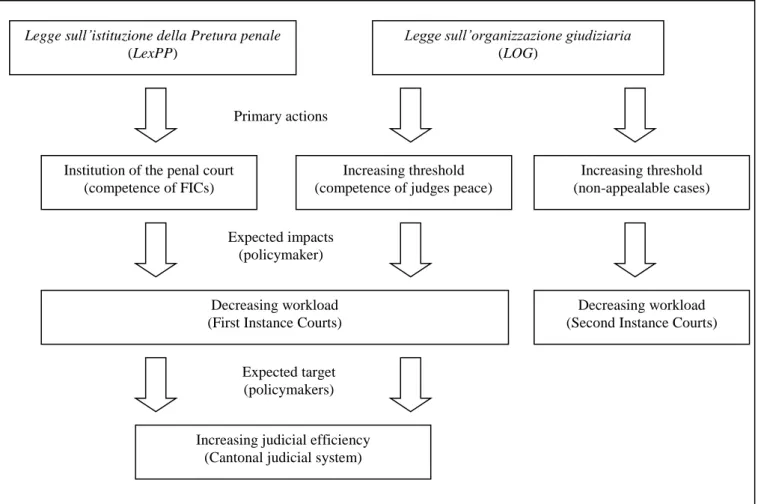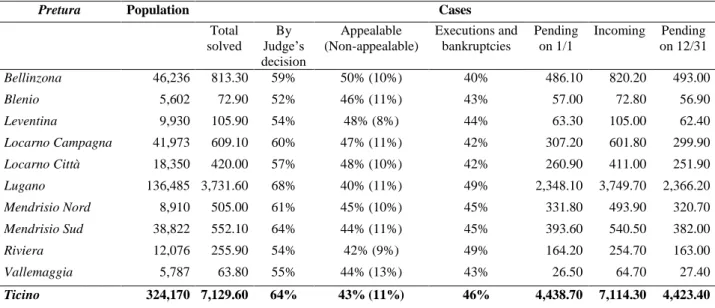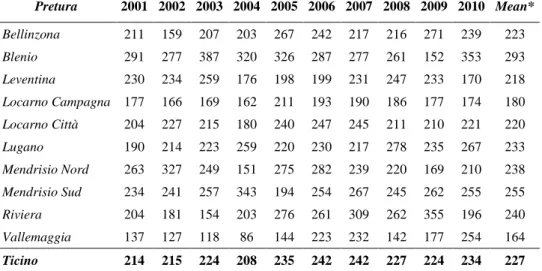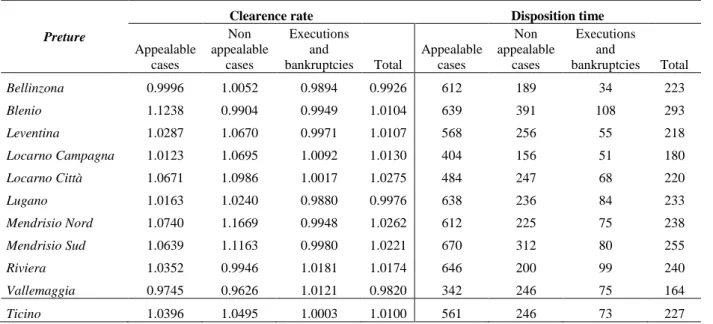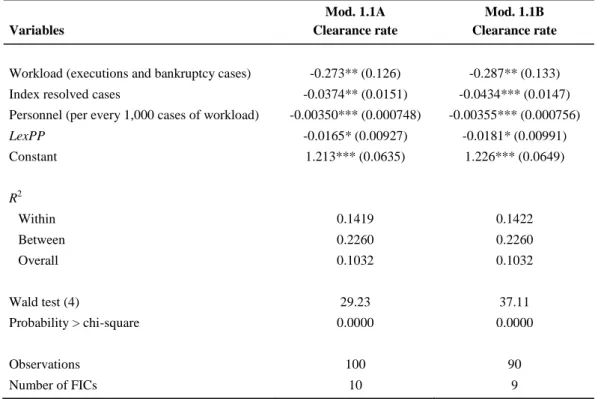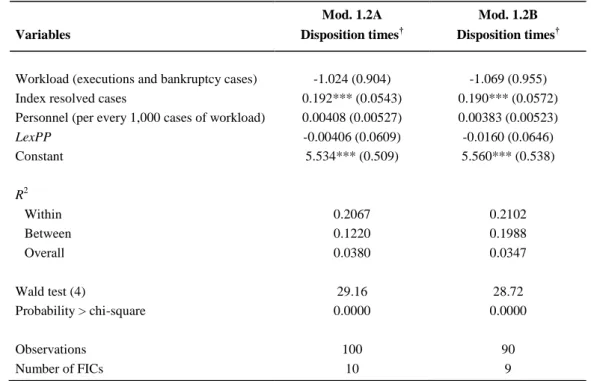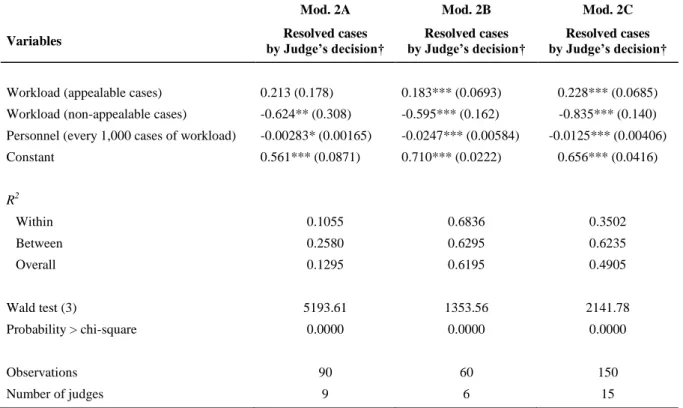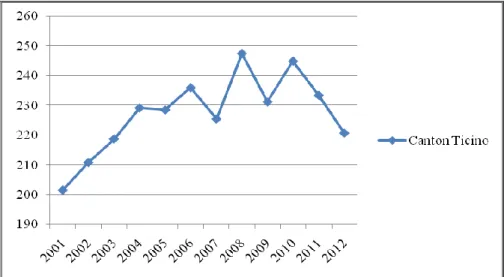IdEP Economic Papers
2014 / 08
1
An analysis of how 2002 judicial reorganisation has impacted on the performance of
the First Instance Courts (Preture) in Ticino
Roberto Ippoliti
1and Massimiliano Vatiero
2Abstract
With data from 2001 to 2010 of the First Instance Courts of the Canton of Ticino, Switzerland, this
paper examines the impact of Legge sull’istituzione della Pretura penale e della funzione di
sostituto Procuratore pubblico (2002), which meant to improve Cantonal court performance by
decreasing penal workload. Our results suggest that such law has posed non-positive effects on
judicial length and courts’ performance. This work may furnish moreover some intuition about the
expected impact of Legge sull’organizzazione giudiziaria (2006), which has adapted cantonal
judicial system to new Swiss Civil Procedure Code, as well policy proposals for the cantonal
programme known as Giustizia 2018.
Keywords: Judicial efficiency, Court performance, civil justice, Ticino
JEL Code: K41, M11
Acknowledgements: We are grateful to Federica De Rossa Gisimundo and Marcello Puca for useful comments. Usual disclaimer applies.
1
Post-Doc in Public Economics, National School of Administration, Presidency of the Council of Ministers (Prime Minister’s Office), roberto.ippoliti@unipmn.it.
2
2
1. Introduction
Judicial systems serve important purposes not only in upholding social values but also in determining economic performance. Well-functioning judiciaries guarantee the security of property rights and the enforcement of contracts, as well as significantly impact on the cost of borrowing loans (Bae and Goyal, 2009; Laeven and Majnoni, 2005). The security of property rights reinforces incentives to save and invest by protecting returns on these activities and, in turn, raising the national GDP (Bianco et al., 2002; Djankov et al., 2008). The good enforcement of contracts stimulates agents to enter into economic relationships by discouraging opportunistic behaviour and reducing transaction costs. Such circumstances positively impact on growth through various channels; they promote competition, foster specialisation in more innovative industries, and contribute to the development of financial and credit markets. Furthermore, judicial systems are significantly related to entrepreneurship (Ardagna and Lusardi, 2008; Ippoliti et al., 2014) and firm growth (Beck et al., 2006; Kumar et al., 2001).
The judiciary organisation in the Canton of Ticino, Switzerland, has been modified during last years, and further reforms are expected. Accordingly, Ticino has promoted the programme known as Giustizia 2018, which has prompted much research on judiciary organisation. The analysis in this paper follows the long tradition of the scientific study of judiciary efficiency at the international level (e.g. the case of European Commission for the Efficiency of Justice, CEPEJ3) by focusing on quantitative data from 2001 to 2010 on the Cantonal judicial system.
In Ticino, the first instance level of the cantonal judicial system consists of judges of the peace and 10 first instance courts (FICs); each FIC is called pretura.4 Judges of the peace are competent for any case of a value less than a certain threshold (the current threshold is 5,000 CHF), while FICs are competent for cases of all higher values, as well as other specific competences (e.g., rent and eviction). By name, Ticino’s 10 FICs are Mendrisio Sud, Mendrisio Nord, Bellinzona, Lugano, Locarno Città, Locarno Campagna, Vallemaggia, Riviera, Leventina, and Blenio. All of these courts but Lugano contain one judge (Pretore) and one staff unit (segretario assessore). The FIC of Lugano involves six sections, each with a specific competence, and six pretore.
While, except for relevant cases, there is in Switzerland a general dearth of empirical and theoretical findings on the mode of operation of the justice system (Lienhard and Kettiger, 2009, 2010; Lienhard et al., 2012; Meier, 1999), several approaches for measuring judiciary efficiency have been proposed in the US and EU: the time needed to define a case (Christensen and Szmer, 2012; Di Vita, 2010; Djankov et al., 2003; Mitsopoulos and Pelagidis, 2007), technical efficiency scores (Falavigna et al., 2014; Ippoliti et al., 2014; Santos and Amado, 2014), the number of cases completed in the court (Beenstock and Haitovsky, 2004; Ramseyer, 2012), and the clearance rate (Buscaglia and Ulen, 1997; CEPEJ, 2012; Dakolias, 1999; Soares and Sviatschi, 2010). In the present study, two measures of judicial efficiency are used: clearance rate and disposition time. Clearance rate indicates whether courts have kept pace with the quantity of incoming cases without increasing their backlog, whereas disposition time refers to the time needed to bring a case to its close.
By analysing Cantonal courts’ clearance rates and disposition times, this paper seeks to contribute a quantitative estimation of both the performance of Ticino’s FICs from 2001 to 2010 and a primary judicial reform enacted in the Canton: Legge sull’istituzione della Pretura penale e della funzione di sostituto Procuratore pubblico (LexPP). Specifically, in 2002, LexPP instituted a central penal Court in Bellinzona, which implied that FICs were exempted from handling penal cases, but that judges of the four smallest FICs
3
CEPEJ was founded by the Committee of Ministers of the Council of Europe in September 2002 in order both to assess the efficiency of judicial systems and to propose practical tools and measures to continually improve the efficiency of judicial services offered to EU citizens.
4
At the second instance level there is a Cantonal appeal court (i.e., Tribunale d'Appello) and, at the third instance level, there is a Federal court (i.e., Tribunale Federale).
3
(i.e., Vallemaggia, Riviera, Leventina, and Blenio) had to work at once in both Bellinzona’s central penal court and their respective FICs.
The results of this analysis can suggest, furthermore, some of the expected results of a successive reform, Legge sull’organizzazione giudiziaria (LOG), which has been issued in 2006, but with significant changes only after 2010. Indeed, in 2011, LOG set new thresholds: The competence of judges of the peace rose from 2,000 to 5,000 CHF, meaning that these judges would hear all cases less than 5,000 CHF in value; at the same time, the threshold for non-appealable cases rose from 8,000 to 10,000 CHF, which decreased the workload for higher courts. This change was a consequence of Article 308 of new Swiss Civil Procedure Code (CPC) reformed in 2008. LOG also instituted a new type of judge—pretore aggiunto—to assist in completing the activities of the pretore and to thus reduce the backlog (articles 32-37).5 Also in this case the position became institutionalised only after 2010, by a new law (Legge di applicazione del codice di diritto processuale civile svizzero del 24/6/2010).
What is the impact of the LexPP on the performance of FICs? And, what are the expected consequences of LOG? To discuss the effects of the cantonal reform in Ticino (LexPP) and to indicate the expected impact of the successive reform (LOG), 6 the remainder of this paper is organised as follows. Section 2 is dedicated to the motivation of this work, illustrating the expected impacts of both reforms. Section 3 presents the methodology to measure judicial efficiency and reports relevant descriptive statistics. Section 4 shows in detail the empirical models used in this study. In Section 4, we explain and discuss our results while, in Section 6, we suggest some policy implication.
2. Motivation
Though LexPP implied that FICs were exempted from handling penal cases, judges of the four smallest FICs (i.e., Vallemaggia, Riviera, Leventina, and Blenio) had to work in both this central penal court and their respective FICs at the same time. LexPP was expected, on the one hand, to reduce the clearance rate and increase the disposition time of the four smallest FICs, since pretore of these FICs are involved in two different courts with increased workloads. On the other hand, since the new penal court judges exempted FICs from all penal cases, LexPP should have improved both the clearance rate and disposition time of other FICs by reducing their workloads.
As abovementioned, LOG defined new thresholds: The competence of judges of peace rose from 2,000 to 5,000 CHF, while the threshold for non-appealable cases rose from 8,000 to 10,000 CHF, the latter of which was a consequence of Article 308 of new CPC. As a reform, LOG is expected to reduce FICs workload and consequently improve their clearance rates and disposition times, since competences transferred cases from FICs to judges of peace. It will also expect to decrease the workload of the second instance courts as a consequence of the higher threshold for non-appealable cases. Moreover taking the new personnel into account (i.e. Pretore Aggiunto), there might be another reduction of workload for every judge.
Figure 1 shows a flowchart that summarises the primary actions of LexPP and LOG and the expected consequences. Observing the figure, readers can better understand the common feature of both reforms, i.e. the reduction of workload to improve FICs performance.
5
There are four pretori aggiunti in the court of Lugano, two in Bellinzona, and one each in Mendrisio Nord, Mendrisio Sud, Locarno Città, and Locarno Campagna. No pretore aggiunto is introduced in the smallest courts (i.e., Vallemaggia, Riviera, Blenio, and Leventina).
6
4
Figure 1. Flowchart of judicial reforms in Ticino
However, in order to confirm, or not, the expected results of the policy maker, an empirical analysis is necessary, taking all determinants of judicial efficiency into account.
3. Data, methodology and descriptive statistics of the Cantonal judicial system in Ticino, 2001–2010
In the present study, two measures of judicial efficiency are used: clearance rate and disposition time. Clearance rate indicates whether courts have kept pace with the quantity of incoming cases without increasing their backlog, whereas disposition time refers to the time needed to bring a case to its close.7 The clearance rate is the relationship between the new cases and completed cases within a period. More specifically, the clearance rate equals the number of resolved cases divided by the number of incoming ones:
where i represents the i-th FIC of Ticino at the year t.
7 An exposition of indexes is offered at the following Counsel of Europe’s website:
https://wcd.coe.int/ViewDoc.jsp?id=1389931&Site=COE (last access: 22 September 2014).
Expected target (policymakers) Expected impacts
(policymaker) Primary actions
Legge sull’organizzazione giudiziaria
(LOG)
Increasing threshold (competence of judges peace)
Increasing threshold (non-appealable cases)
Decreasing workload (Second Instance Courts)
Legge sull’istituzione della Pretura penale
(LexPP)
Institution of the penal court (competence of FICs)
Decreasing workload (First Instance Courts)
Increasing judicial efficiency (Cantonal judicial system)
5
A clearance rate greater than 1 indicates that the Court has satisfied the flow of the demand for justice and decreased the backlog from the previous year, whereas a rate less than 1 indicates that the court has not satisfied the demand for justice and that its backlog has increased. For instance, if in a calendar year 500 new cases were submitted to the court, and the court completed at the same time 550 cases, the clearance rate is 1.10. If the court would complete 400 cases, the clearance rate would be 0.8.
The disposition time is based on the fundamental judicial principle that each case receives a fair trial within a reasonable time (Article 6 of the European Convention on Human Rights). This principle must be fully enacted when managing court workload,8 despite concerns of proceedings duration and specific measures to reduce such duration. According to CEPEJ, disposition time refers to the number of unresolved cases during any period divided by the number of resolved cases at the end of the same period, multiplied by 365 (i.e., the number of days in the considered period), generating data concerning the estimated time that is needed to bring a case to an end:
where i represents the i-th FIC of Ticino at the year t.
The ratio measures how quickly the judicial system turns over received cases – that is, how long it takes for a type of cases to be resolved. This indicator provides further insight into how a judicial system manages its flow of cases (CEPEJ, 2012).9
Data used in this paper are taken from the annual report of the cantonal judicial system (Rendiconto del Consiglio di Stato).10 These data refer to the period from 2001 to 2010. In accordance with the judicial classification, we can separate among appealable civil cases, non-appealable civil cases, executions and bankruptcy cases. The difference between appealable and non-appealable cases is based, among other things, on the value of the cases and the opportunity to propose, or not, an appeal at the second instance level. For executions and bankruptcies, data available are ones referring (only) to the cases of the opposition to the rejection. Moreover, data are distinguished between cases concluded by Judge’s decision and cases concluded by alternative methods such as the withdrawal of a party or a settlement. The report of the cantonal judicial system offers, finally, the number of pending civil cases at the beginning and the end of each year, as well as the number of incoming cases.
Table 1 reports some descriptive statistics for each FIC of Ticino from 2001 to 2010. In details, the third column indicates the average number of cases resolved each year. Though the distribution among FICs is highly irregular, FICs in Ticino resolve on average more than 7,000 cases per year. Table 1 also shows the percentage of civil cases concluded by Judge’s decision, as opposed to being concluded by alternative methods such as the withdrawal of a party or a settlement. For Table 1, it should be noted that the percentage of cases resolved by a Judge’s decision is 52% in Blenio, though the cantonal average is 64%, with the highest value in Lugano (68%). Differences based on conclusions may also be relevant since cases concluded by Judge’s decisions tend to take longer than cases concluded by other means such as an agreement between the parties.
8
Workload refers to the number of cases pending at the beginning of each year added to the number of cases incoming during the year.
9
Note that, even if the formula offers valuable information on the estimated length of proceedings, the ratio does not provide a clear estimate of the average time needed to process each case and it fails to indicate the mix, concentration, or validity of the cases. 10
Data are available at the following link: http://www4.ti.ch/poteri/giudiziario/consiglio-della-magistratura/rendiconti-annuali/ (last access: 25 August 2014).
6
Table 1. Descriptive average statistics of Ticino, 2001–2010
Pretura Population Cases
Total solved By Judge’s decision Appealable (Non-appealable) Executions and bankruptcies Pending on 1/1 Incoming Pending on 12/31 Bellinzona 46,236 813.30 59% 50% (10%) 40% 486.10 820.20 493.00 Blenio 5,602 72.90 52% 46% (11%) 43% 57.00 72.80 56.90 Leventina 9,930 105.90 54% 48% (8%) 44% 63.30 105.00 62.40 Locarno Campagna 41,973 609.10 60% 47% (11%) 42% 307.20 601.80 299.90 Locarno Città 18,350 420.00 57% 48% (10%) 42% 260.90 411.00 251.90 Lugano 136,485 3,731.60 68% 40% (11%) 49% 2,348.10 3,749.70 2,366.20 Mendrisio Nord 8,910 505.00 61% 45% (10%) 45% 331.80 493.90 320.70 Mendrisio Sud 38,822 552.10 64% 44% (11%) 45% 393.60 540.50 382.00 Riviera 12,076 255.90 54% 42% (9%) 49% 164.20 254.70 163.00 Vallemaggia 5,787 63.80 55% 44% (13%) 43% 26.50 64.70 27.40 Ticino 324,170 7,129.60 64% 43% (11%) 46% 4,438.70 7,114.30 4,423.40
Moreover, on average, 43% of the workload represents appealable cases, 11% represents non-appealable cases, and the remaining 46% represents executions and bankruptcy cases. It should be noted that the FIC of Bellinzona differs significantly from the other courts, as it shows the highest percentage of appealable civil cases (50%) and the lowest percentage of executions and bankruptcies (40%).
Table 1 also presents the number of pending civil cases at the beginning and at the end of each year, as well as the number of incoming cases. Such figures allow us to define the demand for civil justice (i.e., the number of pending civil cases at the beginning of each year and the number of incoming cases during the year), the supply of civil justice (i.e., the number of resolved cases during the year), and the backlog (i.e., the number of pending cases at the end of each year)—all of which are shown in Table 2.
Table 2. Descriptive average statistics for Ticino, 2001–2010
Pretura Demand for justice Supply of justice Backlog
Bellinzona 1,306.3 813.3 493 Blenio 129.8 72.9 56.9 Leventina 168.3 105.9 62.4 Locarno Campagna 909 609.1 299.9 Locarno Città 671.9 420 251.9 Lugano 6,097.8 3,731.6 2,366.2 Mendrisio Nord 825.7 505 320.7 Mendrisio Sud 934.1 552.1 382 Riviera 418.9 255.9 163 Vallemaggia 91.2 63.8 27.4 Ticino 11,553 7,129.6 4,423.4
In more detail, Table 3 shows that Ticino’s judicial system can satisfy the demand for justice (i.e., an average clearance rate of 1.010), though the trend is not constant. In fact, Ticino’s clearance rate was less than 1 in
7
three years (2003, 2004, and 2010), due to the poor performance of some FICs—particularly Lugano, which had to satisfy half of the total cantonal demand for justice.
Table 3. Clearance rates in Ticino, 2001–2010
Pretura 2001 2002 2003 2004 2005 2006 2007 2008 2009 2010 Mean* Bellinzona 1.001 1.106 0.951 0.936 0.963 0.972 1.073 1.036 0.922 0.966 0.993 Blenio 1.000 1.000 0.893 1.074 1.102 1.196 1.033 0.959 1.060 0.788 1.010 Leventina 0.935 1.099 0.920 1.083 1.000 1.100 0.968 0.957 1.011 1.034 1.011 Locarno Campagna 1.066 1.024 1.038 0.955 0.936 0.997 1.050 1.020 1.067 0.977 1.013 Locarno Città 1.165 1.025 1.012 0.982 0.956 1.047 1.038 1.122 1.028 0.900 1.027 Lugano 1.030 0.963 1.000 0.932 1.087 1.037 1.054 0.938 1.047 0.889 0.998 Mendrisio Nord 1.061 0.971 1.049 1.027 0.978 0.909 1.053 1.130 1.168 0.917 1.026 Mendrisio Sud 1.087 1.090 1.028 0.855 1.223 1.023 1.004 0.988 0.998 0.925 1.022 Riviera 1.008 1.034 1.039 0.852 0.919 1.060 1.038 1.128 0.941 1.157 1.017 Vallemaggia 1.014 1.065 1.000 1.070 1.000 0.872 0.867 0.978 1.065 0.889 0.982 Ticino 1.037 1.038 0.993 0.976 1.016 1.021 1.018 1.026 1.031 0.944 1.010
*Average clearance rate accounts for the panel (2001–2010).
Figure 2 shows the ranking of FICs according to average disposition time from 2001 to 2010. Blenio has the highest average disposition time.
Figure 2. Descriptive statistics of disposition times at FICs in Ticino, 2001–2010 Table 4. Disposition times in Ticino, 2001–2010
Pretura 2001 2002 2003 2004 2005 2006 2007 2008 2009 2010 Mean* Bellinzona 211 159 207 203 267 242 217 216 271 239 223 Blenio 291 277 387 320 326 287 277 261 152 353 293 Leventina 230 234 259 176 198 199 231 247 233 170 218 Locarno Campagna 177 166 169 162 211 193 190 186 177 174 180 Locarno Città 204 227 215 180 240 247 245 211 210 221 220 Lugano 190 214 223 259 220 230 217 278 235 267 233 Mendrisio Nord 263 327 249 151 275 282 239 220 169 210 238 Mendrisio Sud 234 241 257 343 194 254 267 245 262 255 255 Riviera 204 181 154 203 276 261 309 262 355 196 240 Vallemaggia 137 127 118 86 144 223 232 142 177 254 164 Ticino 214 215 224 208 235 242 242 227 224 234 227
8
Table 4 presents a more detailed descriptive statistics of disposition times. The average disposition time in Ticino is about 227 days, though this average figure has shown an increasing trend. Moreover, if we consider a single court, the trend is not as constant.
Table 5 proposes the disposition time and the clearance rate for each case-law, i.e. considering executions and bankruptcies, appealable and non-appealable cases. According to data, only in four FICs the clearance rate of executions and bankruptcies cases is higher than 1 (i.e. Locarno Città, Locarno Campagna, Riviera and Vallemaggia). It is worthy to underline that, though the time necessary to define an execution and bankruptcy case is estimated to be the lower (i.e. 73 days) than appealable (561 days) and non-appealable (246 days) cases, the clearance rate is lower in executions and bankruptcies (1.0003) than appealable (1.0396) and non-appealable (1.0495). It means that, though cases involving executions and bankruptcies are more rapid than appealable and non-appealable cases, the decreasing of workload in executions and bankruptcies is lower rapid than appealable and non-appealable cases.
Table 5. Disposition times and clearance rate in Ticino, 2001–2010
Preture
Clearence rate Disposition time
Appealable cases Non appealable cases Executions and bankruptcies Total Appealable cases Non appealable cases Executions and bankruptcies Total Bellinzona 0.9996 1.0052 0.9894 0.9926 612 189 34 223 Blenio 1.1238 0.9904 0.9949 1.0104 639 391 108 293 Leventina 1.0287 1.0670 0.9971 1.0107 568 256 55 218 Locarno Campagna 1.0123 1.0695 1.0092 1.0130 404 156 51 180 Locarno Città 1.0671 1.0986 1.0017 1.0275 484 247 68 220 Lugano 1.0163 1.0240 0.9880 0.9976 638 236 84 233 Mendrisio Nord 1.0740 1.1669 0.9948 1.0262 612 225 75 238 Mendrisio Sud 1.0639 1.1163 0.9980 1.0221 670 312 80 255 Riviera 1.0352 0.9946 1.0181 1.0174 646 200 99 240 Vallemaggia 0.9745 0.9626 1.0121 0.9820 342 246 75 164 Ticino 1.0396 1.0495 1.0003 1.0100 561 246 73 227
Finally, the table 6 reports the average clearance rates and disposition times before and after the cantonal reform (LexPP).
Table 6. Judicial system before and after LexPP reform in Ticino, 2001–2010
Period Clearance rate Disposition times Workload (Appealable cases)
Workload (Executions and bankruptcies) Total workload Before LexPP (2001–2002) 1.0373 224 0.4331 0.4514 1,236 After LexPP (2003–2010) 1.0031 228 0.4575 0.4412 1,135 Total (2001–2010) 1.0100 227 0.4526 0.4432 1,155
According to these data, the average clearance rate from 2001 to 2002 was 1.0373, which decreased to 1.0031 after LexPP. In terms of disposition time, the reform lengthened case duration. In this sense, LexPP does not seem to have improved FIC performance. However, it is necessary to analyse all determinants of
9
judicial efficiency together in order to correctly estimate and better understand the poor outcomes of the LexPP reform, since several causes might have each partly affected FIC performance.
4. Empirical Model
To explain cantonal judicial efficiency and the impact of LexPP and the expected consequences of LOG, we have accounted for the following variables:
Workload (executions and bankruptcies), which equals the percentage of such cases out of the total
workload; note that we refer only to data of cases of the opposition to the rejection.
Workload (appealable cases), which equals the percentage of such cases out of the total workload;
Workload (non-appealable cases), which equals the percentage of such cases out of the total
workload;
Index of resolved cases, which equals to the number of cases resolved in the court by a decision out of
the number of cases resolved by alternative means;
LexPP, which is an ordinal categorical variable equal to 0 (for all courts before 2003), -1 (for courts
with a judge who must work in the unique penal court in Bellinzona after 2003), and 1 (for courts with a judge who does not have to work in the unique penal court in Bellinzona after 2003);
Personnel rate, which equals the number of court workers (i.e., pretore and segretario assessore) per
every 1,000 cases of workload.
The empirical analysis proposed in this section is based on multiple regression models involving random effect, panel data, and robust option. Three models are proposed.
Model 1 concerns the determinants of judicial efficiency and the impact of the law, as follows:
Clearance_ratei,t = β0 + β1 Resolved_casesi,t + β2 Workload_Executionsi,t + β3 Personneli,t + β4 LexPPi,t + εi,t
Disposition_timei,t = β0 + β1 Resolved_casesi,t + β2 Workload_Executionsi,t + β3 Personneli,t + β4 LexPPi,t + εi,t
in which i represents the i-th FIC of Ticino at the year t, while ε the error.
Since the three variables of appealable, non-appealable, and executions and bankruptcy cases are categorical variables, one must be dropped for collinearity, which is the base category against which the other(s) are assessed (Suits, 1957). The intercept of the model represents the omitted categories: the residual workload (appealable and non-appealable cases) and cases resolved by other means.
To obtain more robust results, this analysis proposes two sub-models: Model A, which considers all cantonal courts, and Model B, which considers all courts but Lugano, since it represents more than half of the demand for justice, meaning that the performance of the total cantonal system might be unduly affected by this one court (Table 2). In both Models A and B, the Hausman test has been applied to verify whether the random effect is more appropriate than the fixed one (e.g., considering the clearance rate, the p-value in Model A is 0.2135).11 To verify collinearity among variables, the pairwise correlation has been tested with acceptable values.
11
Authors didn’t find significant differences between fixed and random effects: both models confirm the same statistically significant coefficients and the estimated degree of the change between random effect and fixed effect is not relevant.
10
Table 7 presents the results of the Model 1 with clearance rate as the dependent variable. Both Models 1.1A and 1.1B are statistically significant (Wald test)12 with an acceptable R2. Considering the between R2, the variance of the dependent variable explained by the explanatory variables is 22.60% both in Model 1.1A and in Model 1.1B, while, considering the within R2, the variance is 14.19% in Model 1.1A and 14.22% in Model 1.1B. These results are reasonable if we consider the heterogeneity of the sample, which is lower within the panel but higher among observations.
Table 7. Multiple regression model involving panel data, random effect, and robust option for Ticino, 2001–2010
Mod. 1.1A Mod. 1.1B
Variables Clearance rate Clearance rate
Workload (executions and bankruptcy cases) -0.273** (0.126) -0.287** (0.133) Index resolved cases -0.0374** (0.0151) -0.0434*** (0.0147) Personnel (per every 1,000 cases of workload) -0.00350*** (0.000748) -0.00355*** (0.000756)
LexPP -0.0165* (0.00927) -0.0181* (0.00991) Constant 1.213*** (0.0635) 1.226*** (0.0649) R2 Within 0.1419 0.1422 Between 0.2260 0.2260 Overall 0.1032 0.1032 Wald test (4) 29.23 37.11 Probability > chi-square 0.0000 0.0000 Observations 100 90 Number of FICs 10 9 *p < 0.1, **p < 0.05, ***p < 0.01 Robust standard errors in parentheses.
Results suggest that increasing the percentage of executions and bankruptcy cases in the total workload decreases the clearance rate. In both Models 1.1A and 1.1B, the coefficients are statistically significant (p < 0.05). This result is coherent with the data proposed in table 5. Indeed, table 5 shows that the clearance rate in this specific case law is significantly lower than the others, even if the time necessary to define a case is relatively low. Moreover, we find that increasing the number of cases resolved by Judge’s decision with respect the number resolved in other ways, courts performance will decrease (p < 0.05). Obviously, the effect of the dropped variables (i.e., the base categories against which the others are assessed) is represented by the intercept, which is positive and statistically significant (p < 0.01).
Considering personnel, this result suggests that the number of workers per every 1,000 cases negatively impacts the clearance rate, meaning that decreasing the workload or increasing the personnel will negatively impact court performance (p < 0.01). This is consistent with the literature since it suggests that decreasing the pressure on judges can decrease their productivity (Beenstock and Haitovsky, 2004). Indeed, since the number of staff and the number of judges did not change in the period, workload has affected court
12
The Wald test assesses the hypothesis that at least one of the predictors’ regression coefficients is not equal to zero. The number in the parentheses indicates the degrees of freedom of the chi-square distribution used to test the Wald test statistic and is defined by the number of predictors in the model.
11
productivity. As such, the results suggest that decreasing the workload and maintaining the same number of personnel, the court performance will decrease.
Table 8. Multiple regression model involving panel data, random effect, and robust option for Ticino, 2001–2010
Mod. 1.2A Mod. 1.2B
Variables Disposition times† Disposition times†
Workload (executions and bankruptcy cases) -1.024 (0.904) -1.069 (0.955) Index resolved cases 0.192*** (0.0543) 0.190*** (0.0572) Personnel (per every 1,000 cases of workload) 0.00408 (0.00527) 0.00383 (0.00523)
LexPP -0.00406 (0.0609) -0.0160 (0.0646) Constant 5.534*** (0.509) 5.560*** (0.538) R2 Within 0.2067 0.2102 Between 0.1220 0.1988 Overall 0.0380 0.0347 Wald test (4) 29.16 28.72 Probability > chi-square 0.0000 0.0000 Observations 100 90 Number of FICs 10 9 * p < 0.1, **p < 0.05, *** p < 0.01 †Logarithmic transformation Robust standard errors in parentheses.
Table 8 shows the role of the LexPP with the disposition time as the dependent variable: Both Models 1.2A and 1.2B are statistically significant (Wald test) and have acceptable R2, taking the number of observations and variables into account. Considering the between R2, the variance of the dependent variable explained is 12.20% in Model 1.2A and 19.88% in Model 1.2B, while, considering the within R2, the variance is 20.67% in Model 1.2A and 21.02% in Model 1.2B.
Both models suggest that cases needing Judge’s decisions lengthen the time needed for courts to process cases more than cases decided by other means. This result is statistically significant (p < 0.01), though there are no other statistically significant results but the intercept of the model. This outcome might rely on litigation among parties, as well the opportunity to propose an appeal at the second instance courts. In this sense, the reduction of opportunity to propose an appeal at a second instance court as introduced by LOG (threshold for non-appealable cases rose from 8,000 to 10,000 CHF) might provide incentives to achieve an agreement among parties, meaning that the case does not requires a judge’s final decision. If correct, we can expect that increasing of the threshold of non-appealable cases, as LOG does after 2010, will reduce the resolved cases with Judge’s decision.
Model 2 focuses on FICs to test the hypothetical impact of litigiousness, i.e. whether the increased threshold
of non-appealable cases was able to decrease the litigiousness among parties and thus increase court performance. In this sense, it also tests whether adherence to federal legislation will decrease litigiousness and thus will increase court efficiency. Indeed, the main analysis suggests that any case requiring a judge to make a final Judge’s decision can decrease court efficiency and, as such, the court’s clearance rate.
12
Three sub-models are proposed: considering all FICs but Lugano (Mod. 2.A), considering all sections of the FICs of Lugano (Mod. 2.B) and considering all judges, which means all FICs and sections together (Mod. 2.C). In other words, considering each single judge of the cantonal system, this analysis seeks to estimate whether litigiousness affects judicial efficiency. The proxy for litigiousness is the possibility of proposing an appeal at the second instance courts. Model 2 is as follows:
Resolved_casesi,t = β0 + β1 Workload_non-appealablei,t + β2 Workload_appealablei,t + β3 Personneli,t + εi,t
in which i represents the i-th FIC of Ticino at the year t, while ε the error.
Table 9. Multiple regression model involving panel data, random effect, and robust option, 2001–2010
Mod. 2A Mod. 2B Mod. 2C
Variables by Judge’s decision† Resolved cases by Judge’s decision† Resolved cases by Judge’s decision† Resolved cases
Workload (appealable cases) 0.213 (0.178) 0.183*** (0.0693) 0.228*** (0.0685) Workload (non-appealable cases) -0.624** (0.308) -0.595*** (0.162) -0.835*** (0.140) Personnel (every 1,000 cases of workload) -0.00283* (0.00165) -0.0247*** (0.00584) -0.0125*** (0.00406) Constant 0.561*** (0.0871) 0.710*** (0.0222) 0.656*** (0.0416) R2 Within 0.1055 0.6836 0.3502 Between 0.2580 0.6295 0.6235 Overall 0.1295 0.6195 0.4905 Wald test (3) 5193.61 1353.56 2141.78 Probability > chi-square 0.0000 0.0000 0.0000 Observations 90 60 150 Number of judges 9 6 15 *p < 0.1, **p < 0.05, ***p < 0.01 Robust standard errors in parentheses.
† percentage of cases defined by Judge’s decision out of the total number of cases resolved by the judge
Table 9 shows the results of Model 2, which is statistically significant (Wald test) and has a very high R2. Considering the between R2, the variance of the dependent variable explained by the model is 25.80 % in the model 2.A, and it raises more than 62 % in the model 2.B and 2.C. In both cases, the extremely high R2 depends upon the sections of the FIC of Lugano, which is clearly due to the reallocation of workload among the sections (i.e. high level of heterogeneity among sections).
Model 2’s results suggest that, by increasing the percentage of appealable cases in the total workload, the percentage of cases resolved by Judge’s decision will increase (p < 0.01). By contrast, decreasing the percentage of non-appealable cases in the total workload decreases the percentage of cases resolved by Judge’s decision, meaning that the percentage of cases resolved by other means will increase (p < 0.01). According to these results, the opportunity to propose an appeal increases litigiousness and, in turn, judicial inefficiency in Ticino’s courts by increasing the time needed to resolve cases.
13
5. Results and discussion
Table 10 summarises our results. They indicate that an increasing of executions and bankruptcies in respect to the total workload reduces the clearance rate, though it has no significant effects on disposition time. The same first result occurs if we consider the number of cases resolved by Judge’s decision out of the total number of concluded cases, though this variable also positively affects disposition time. As such, cases resolved by Judge’s decision require more time than cases resolved by alternative means and, in turn, decrease court productivity.
Considering personnel (i.e. judges and staff), literature shows a theoretical negative impact on clearance rate if we decrease the workload (Beenstock and Haitovsky, 2004). This result suggests that decreasing the pressure on judges’s workload—which might represent the labour pressure put on judges without an appropriate incentive system to maximise their activity— can also diminishing their productivity. That is, for the same workload, judges complete more cases under pressure, yet complete fewer cases when new judges are appointed. It should also be noted that the number of judges and staff do not significantly impact on disposition time.
Finally, LexPP had a negative and statistically significant impact on clearance rate, which indicates the negative impact of the law on court performance. If we consider disposition time as a measure of judicial efficiency, then there is no significant effect on court performance.
Table 10. Results of our empirical model (expected and estimated impact on court performance)
Variables Effect on Court Performances
Executions and bankruptcy cases Decreases clearance rate (negative effect on court efficiency); Irrelevant to disposition time*
Resolved cases with Judge’s decisions Decreases clearance rate (negative effect on court efficiency); Increases disposition time (negative effect on court efficiency) Personnel Decreases clearance rate (negative effect on court efficiency);
Irrelevant to disposition time*
Workload Decreases clearance rate (negative effect on court efficiency); Irrelevant to disposition time*
LexPP Decreases clearance rate (negative effect on courts’ efficiency);
Irrelevant to disposition time*
Threshold for non-appealable cases (LOG) Decreases the percentage of cases resolved by Judge’s decision (i.e., the litigiousness of parties), that is, expected positive effect on court efficiency
Threshold for judges of peace (LOG) Decreases the workload, that is, expected negative effect on court efficiency *p > 0.1; see Section 4 for the empirical model.
Our results offer also some suggestions on the expected impact of the LOG. We can affirm that the opportunity to propose an appeal against the judge’s decision can increase the parties’ propensity to litigate instead of reaching an agreement. In this sense, the possibility of proposing an appeal at a second instance court might preclude any (amicable) agreement among parties and require a final decision to be made by a judge, which increases the time necessary to define the case. In effect, increasing of threshold of non-appealable cases (as introduced by LOG, in order to align cantonal regulation with federal regulations, such as those posed by the Swiss CPC) might decrease the time that Ticino’s courts require to process cases and, in this way, increase court efficiency.
Nonetheless, the LOG increased both the threshold of judges of peace and the number of judges (Pretore aggiunto). It could imply a lower level of pressure on each judge in the FICs. Hence, without an appropriate
14
incentive system on judges, the positive impact deriving from new threshold of non-appealable cases may be not sufficient to produce a significant positive impact to the courts performance since judges effort could be negatively affected by the decrease of the workload. A preliminary evidence can be derived from data which are available only at cantonal level after 2010 (i.e. aggregate data).
Figure 3. Trend of the cantonal clearance rate in Ticino (2001-2012)
Figure 4. Trend of the cantonal disposition time in Ticino (2001-2012)
The impact both in the case of clearance rate and of disposition time seems to be positive as well showed by figures 3 and 4.13 However, the aggregate clearance rate decreased dramatically after the year 2011. Could such diminishing of clearance rate derive from a reduction of pressure on judicial staff? Further researches and data should analyze such circumstance.
13
Note that in figures 3 and 4 we refer to aggregate clearance rate and aggregate disposition time of Canton Ticino instead of the average of cantonal FICs, which have been proposed in the tables 3 and 4.
15
6. Policy implications
The results of this study suggest that LexPP has negatively affected court efficiency, even if it was able to decrease the workload of the most visited courts and, in turn, to increase judges’ availability. As such, the policy aimed at establishing that pretore of the smallest FICS must also work in the Tribunale Penale did not succeed.
Moreover, findings of this study indicate that changing the threshold of non-appealable cases as pushed by the Swiss CPC and as introduced by LOG might decrease the propensity of parties to seek decisions by the courts, provided that there is not the possibility to appeal. In line with the current literature (Bianco et al., 2007; CEPEJ, 2012), the study can support the hypothesis that litigiousness might be one of the determinants of judicial inefficiency, creating costs, not only for the disputing parties, but also for society as a whole. Trials tie up tangible and scarce social resources, such as the time of the parties, their lawyers, their judges, and their witnesses, to name a few.
In order to improve the efficiency of the cantonal judicial system this work may suggest the following proposals. A first suggestion is that Ticino strongly facilitates alternative dispute resolution (ADR) procedures. Even if court proceedings are the traditional means used by legal systems for settling disputes and have developed into their current form over many centuries, disputes need not be settled in court only. ADR procedures (e.g., mediation) coexist alongside statutory rules regarding the settlement of disputes. To reduce litigiousness, lawmakers might regulate lawyer fees (Ippoliti, 2014) and/or court fees in order to stimulate ADRs and discourage appeals, since research has shown that these fees could be linked to ADRs (Bernstein, 1993; Shavell, 1995).
Since court fees might reduce the public expense by passing part of judicial costs to the market (Esposito et al., 2014), a better balanced distribution of litigation costs between taxpayers and the market might reduce the inflow of cases. The application of similar courts fees has increased throughout Europe in the last years, in the UK, the Netherlands, Germany, and France, among others (Faure, 2006; Hodges et al., 2010; CEPEJ, 2012).
Nevertheless, the reduction of the workload by higher fees is not a sufficient solution if an appropriate incentive system for judges and staff is not in place. The literature shows that an appropriate motivation system should be developed by the policymaker (Cooter, 1983; Deyneli, 2012; Posner, 1993).
A further implication of our results is that executions and bankruptcy cases, even if they are significantly shorter, they reduce the performance of cantonal courts in terms of clearance rate. Further studies should thus focus on executions and bankruptcy procedures and the level of personnel and specialization of judges. For instance, since the specialisation of a magistrate in a specific topic might increase judges’ productivity (Marchesi, 2003), a specific FIC with a competence for executions and bankruptcies might increase cantonal efficiency (e.g., pretori aggiunti might work in such a court). A more in-depth analysis of the fifth section of the FIC of Lugano, which retains personnel dedicated to bankruptcies and executions, might produce insights for further studies, as well as guide policymakers in making future reforms.
16
Bibliography
Ardagna, S & Lusardi, A 2008, ‘Explaining International Differences in Entrepreneurship: The Role of Individual Characteristics and Regulatory Constraints’, NBER Working Paper, no. 14012.
Bae, KH & Goyal, VK 2009, ‘Creditor rights, enforcement, and bank loans’, Journal of Finance, Vol. 64, no. 2, pp. 823–60.
Beck, T, Demirguc-Kunt, A & Maksimovic, V 2006, ‘The influence of financial and legal institutions on firm size’, Journal of Banking and Finance, Vol. 30, pp. 2995–3015.
Beenstock, M & Haitovsky, Y 2004, ‘Does the appointment of judges increase the output of the judiciary?’, International Review of Law and Economics, vol. 24, pp. 351-369.
Bernstein L 1993, ‘Understanding the limits of Court-Connected ADR: a critique to Federal Court – annexed arbitration program’, University of Pennsylvania Law Review, vol. 141, no. 6, pp. 2169-2252.
Bianco, M, Jappelli, T & Pagano, M 2002, ‘Courts and Banks: Effects of Judicial Enforcement on Credit Markets’, Journal of Money, Credit, and Banking, Vol. 37, no. 2, pp. 223-44.
Bianco, M, Giacomelli, S, Giorgiantonio, C, Palumbo, G & Szego, B 2007, 'La durata (eccessiva) dei procedimenti civili in Italia: offerta, domanda o rito?', Rivista di Politica Economica, pp. 3-52.
Buscaglia, E & Ulen, T 1997, ‘A quantitative assessment of the efficiency of the judicial sector in Latin America’, International Review of Law and Economics, Vol. 17, no. 2, pp. 275-291.
Christensen, RK & Szmer, J 2012, ‘Examining the efficiency of the U.S. courts of appeals: Pathologies and prescriptions’, International Review of Law and Economics, Vol. 32, no. 1, pp. 30-37.
Cooter, RD 1983, ‘The Objectives of Private and Public Judges’, Public Choice, Vol. 41, pp- 107-132 Dakolias, M 1999, ‘Courts Performance around the World, a Comparative Perspective’, World Bank Technical Paper, no. 430.
Deyneli, F 2012, ‘Analysis of relationship between efficiency of justice services and salaries of judges with two-stage DEA method’, European Journal of Law and Economics, Vol. 34, no. 3, pp. 477-493.
Di Vita, G 2010, 'Production of laws and delays in court decisions', International Review of Law and Economics, Vol. 30, no. 3, pp. 276-281.
Djankov, S, La Porta, R, Lopez-de-Silanes, F & Shleifer, A 2003, ‘Courts’, Quarterly Journal of Economics, Vol. 118, no. 2, pp. 453–517.
Djankov, S, Hart, O, McLiesh, C & Shleifer, A 2008, ‘Debt Enforcement around the World’, Journal of Political Economy, Vol. 116, pp. 1105–1149.
Esposito, G, Lanau, S & Pompe, S 2014, ‘Judicial System Reform in Italy - A Key to Growth’, IMF Working Paper, no. WP/14/32
European Commission for the Efficiency of Justice (CEPEJ) 2012, Evaluation of European Judicial Systems - CEPEJ Report.
17
Falavigna, G, Ippoliti, R, Manello, A & Ramello, GB 2014, ‘Judicial productivity, delay and efficiency: a Directional Distance Function (DDF) approach’, forthcoming on European Journal of Operational Research.
Faure, MMG & Moerland, CAG 2006, Court Fees: A Comparative Description of Court Fee Systems in Some Member States of the European Union, The Hague: Boom Juridische Uitgevers.
Hodges, C, Vogenauer, S & Tulibacka, M 2012, The Costs and Funding of Civil Litigation: A Comparative Perspective, Hart Publishing.
Ippoliti, R 2014, ‘La competitività del Mercato Forense e l’efficienza giudiziaria’, Economia Pubblica, Vol. 2.
Ippoliti, R, Melcarne, A & Ramello, G 2014, ‘Judicial Efficiency and Entrepreneurs’ Expectations on the Reliability of European Legal Systems’, forthcoming on European Journal of Law and Economics.
Kumar, K, Rajan, R & Zingales, L 2001, ‘What determines firm size?’, NBER Working Paper, no. 7208. Laeven, L & Majnoni, G 2005, ‘Does judicial efficiency lower the cost of credit?’, Journal of Banking & Finance, Vol. 29, pp. 1791–1812.
Legge sull’istituzione della Pretura penale e della funzione di sostituto Procuratore pubblico 2002. Legge sull’organizzazione giudiziaria 2006.
Legge di applicazione del codice di diritto processuale civile svizzero 2010.
Lienhard, A & Kettiger, D 2009, ‘Geschäftslastbewirtschaftung bei Gerichten: Methodik, Erfahrungen und Ergebnisse einer Studie bei den kantonalen Verwaltungs- und Sozialversicherungsgerichten’ ZBl 8/2009, p. 413 ff.
Lienhard, A & Kettiger, D 2010, ‘Caseload Management in the Law Courts’, International Journal For Court Administration, November 2010.
Lienhard, A, Kettiger, D & Winkler, D 2012, ‘Status of Court Management in Switzerland’, International Journal For Court Administration, December 2012
Marchesi, D 2003, Litiganti, avvocati e magistrati: diritto ed economia del processo civile, Il mulino, Bologna.
Meier, P 1999, ‘New Public Management in der Justiz’, Bern 1999.
Mitsopoulos, M & Pelagidis, T 2007, ‘Does staffing affect the time to dispose cases in Greek courts?’, International Review of Law and Economics, Vol. 27, no. 2, pp. 219-244.
Organisation for Economic Co-operation and Development (OECD) 2013, What makes civil justice effective?, OECD Economics Department Policy Notes, no. 18.
Posner, RA 1993, ‘What do judges and justices maximize? (the same as everybody else does)’, Supreme Court Economic Review, vol. 3, pp. 1–41.
Ramseyer, JM 2012, ‘Talent matters: Judicial productivity and speed in Japan’, International Review of Law and Economics, Vol. 32, no. 1, pp. 38-48.
18
Santos, SP & Amado CAF 2014, ‘On the need for reform of the Portuguese judicial system – Does Data Envelopment Analysis assessment support it?’, Omega, vol. 47, pp. 1–16.
Shavell, S 1995, ‘Alternative dispute resolution: an economic analysis’, Journal of Legal Studies, Vol. 24, no. 1, pp. 1-28.
Soares, Y & Sviatschi, MM 2010, ‘The Impact of Modernization of Justice on Court Efficiency in Costa Rica’, Working paper Office of Evaluation and Oversight, Inter-American Development Bank, no. WP/OVE-06/10.
Suits, DB 1957, ‘Use of dummy variables in regression equations’, Journal of the American Statistical Association, Vol. 52, no. 280, pp. 548–551.
